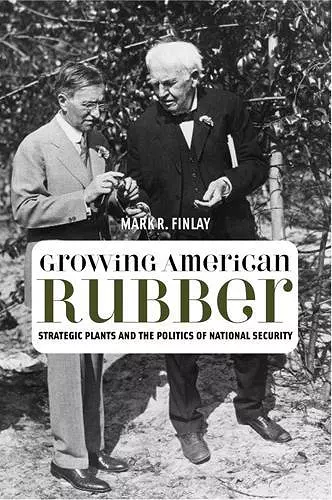Growing American Rubber
Strategic Plants and the Politics of National Security
Format:Paperback
Publisher:Rutgers University Press
Published:13th Mar '13
Currently unavailable, and unfortunately no date known when it will be back

Growing American Rubber explores America's quest during tense decades of the twentieth century to identify a viable source of domestic rubber. Straddling international revolutions and world wars, this unique and well-researched history chronicles efforts of leaders in business, science, and government to sever American dependence on foreign suppliers. Mark Finlay plots out intersecting networks of actors including Thomas Edison, Henry Ford, prominent botanists, interned Japanese Americans, Haitian peasants, and ordinary citizensùall of whom contributed to this search for economic self-sufficiency. Challenging once-familiar boundaries between agriculture and industry and field and laboratory, Finlay also identifies an era in which perceived boundaries between natural and synthetic came under review.
Although synthetic rubber emerged from World War II as one solution, the issue of ever-diminishing natural resources and the question of how to meet twenty-first-century consumer, military, and business demands lingers today.
"Finlay's narrative is at its best when he details this interface of economy, ecology, and politics, supported by extensive archival research into seemingly every prospect for growing rubber." * Isis *
"Growing American Rubber is a significant contribution to many fields, not the least of which is the history of technology and science. Finlay deftly weaves stories of diplomacy, scientific research, interest-group politics, entrepreneurs, farmers, laborers, and the environment to tell the story of rubber-crop research in the first half of the twentieth century." * Technology and Culture *
"A fascinating, well-written, and timely study." * American Historical Review *
"Finlay has written an engaging, poignant work that demonstrates the strategic connection between agriculture, industry, and national defense and shows the importance of rubber to American industrial and military might. Finlay consulted a variety of archival sources to produce this thoroughly researched, well-documented work. He tells an important story that has broader implications for diplomatic historians and scholars who study the importance of agriculture and industry. Recommended." * Choice *
"Finlay's excellent book indicates just how central rubber has been to American history since the start of the twentiety century."
* H-Net Reviews *
"By moving beyond the well-known stories of Edison's and Ford's efforts to find domestic sources of rubber, Mark Finlay provides readers with a fresh and important analysis of the connections between military and economic national security and access to a vital strategic natural resource that has implications for the present day." -- Paul Israel * director and editor, Thomas A. Edison Papers, Rutgers University *
"At last, the humble rubber plant takes center stage, vividly demonstrating the interdependence of agriculture and industry in twentieth-century America. A remarkable and timely book!" -- Deborah Fitzgerald * author of Every Farm a Factory: The Industrial Ideal in American Agriculture *
"Mark Finlay's research has been extensive and is unlikely to be duplicated any time in the near future. He writes with fluency and great narrative verve and he successfully weaves together the biological, technological, economic, political, and military strands of a complex story." -- Philip J. Pauly * author of Fruits and Plains: The Horticultural Transformation of America *
"This is a good story, well-told. The range and variety of resources that Finlay has explored is first-rate. As we now debate the sustainability of natural resources, the themes of this book could not be more relevant." -- David E. Wright * professor in the College of Agriculture and Natural Resources at Michigan State *
"Finlay's well-researched work makes clear the importance of rubber in American history. The United States shifted from domestic organic to inorganic and foreign solutions to the modern consumer driven economy. Unfortunately the United States still relies on a risky combination of imported natural rubber and synthetic rubber derived from petroleum, making this study timely and relevant."
* Southwestern Historical Quarterly *
"Mr. Finlay has produced an outstandingly well-documented and thoroughly researched narrative of the history of the modest rubber plant."
* HUNTIA *ISBN: 9780813561578
Dimensions: 229mm x 152mm x 18mm
Weight: 680g
360 pages